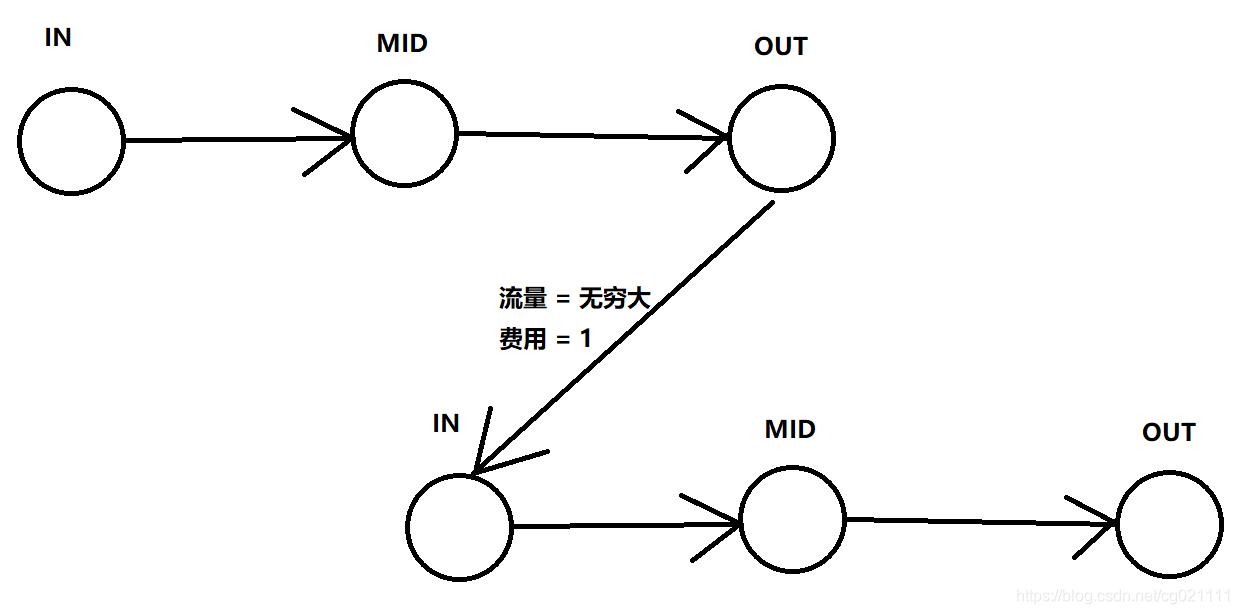P3159 [CQOI2012]交换棋子 网络流拆点造图
P3159 [CQOI2012]交换棋子
洛谷P3159.
分析:
1:把白棋看作空的位置,那么只需要 移动黑棋子就行了. 在一个黑棋的移动路径中,除了第一个位置和最后一个位置,其余位置都是小号 两次交换次数. 因为一次从其他地方走到当前,一次从当前再走出去.共两次.
2: 如果当前点起始和终止都有棋子,那么相当于这个位置没有棋子. 因为考虑这个点的棋子不移动,那么其他棋子的移动都要绕着这个棋子过.显然这个棋子相当于没有移动过, 也就不需要考虑. 再如果, 别的棋子需要移到当前的棋子,而当前的棋子最终要落在其他的坐标上,那么就相当于其他的棋子踩在这个棋子的头上过去了,因为整个变化的路线完全一致.
那么这里的做法就是把一个坐标点拆成3个点,即 in, mid, out,in到mid连线表示是从其他点走到当前的, 从mid到out连线 表示是从当前到外面的其他坐标的移动. 而权值显然应该围绕该点的总的改变次数赋值. 但是赋值怎么 进行呢? 考虑到一个点进来和出去的次数差值不会超过1, 所以如果最大的允许改变次数是偶数可以 两个边权值都一样,不会出现问题,那么问题就是如果某一个点的最大允许的改变次数是奇数,那么被两个边分,就会多出1权值,这个1的分配是比较讲究的.这么想:
这里画了两个点之间拆点完之后的连线图, 其他更多的点都用同理来造图

如果当前的奇数值的点在起点处有棋子,那么如果终点处没有棋子,很明显,出来的交换次数要多1,那么把这个1赋值给mid 到 out的连边
如果当前的奇数值的点在起点处有棋子,那么如果终点处也有棋子,根据上面的分析2,相当于这个点没有棋子存在,那么即使有路径通过这里,进来和出来的次数一定一样,所以这个1无论给那一条边都没有关系
如果当前的奇数值的点在起点处没有棋子,那么如果终点处也没有棋子,那么同上:即使有路径通过这里,进来和出来的次数一定一样,所以这个1无论给那一条边都没有关系.
如果当前的奇数值的点在起点处没有棋子,那么如果终点处有棋子,那么很明显,进来的次数要多1,那么把这个1加给in 到mid 的连边.
那么拆点到这里就算完成了.
以上所有,费用全部为0
那么点之间怎么连接呢? 题中说了,一个点有八个方向都可以连通,那么如果两个点可以连通, 把对应的out连到另一个点的in点中就可以,费用为1.(因为我们需要用费用类比交换次数,所以一次的点之间的交换就是1个费用)
再之后,源点连接初始有棋子的坐标点,连接mid. 终止状态有棋子的坐标点的mid与汇点连接.费用为0, 流量为1.
那么如果我没有说落了什么的话造图就到这里全部结束.
那么我们分析这个图怎么用: 因为源点S连的是初始有棋子的坐标, 并且容量为1,那么我们可以看作一个棋子的转移路径就是一个流量,所以最大流和棋子数一致,说明可以顺利完成题目中的棋子移动.而费用就是转移的次数,因为我们的1费用设给了点之间转移的边, 所以是可以对应上的.
总之,题中所求的最小交换次数就是费用.
那么无解的情况就是一个流量与数据中棋子的数量不一致,或者数据中起始的棋子数和终止的棋子数不同,那么输出-1.
#include <bits/stdc++.h>
using namespace std;
const int maxn = 2e5 + 60;
const int maxm = 2e5 + 60;
typedef long long ll;
struct edge
{
int s, d, next;
ll cap, cost;
};
struct graph
{
edge saveedges[maxm];
int savecnt = 0;
int head[maxn] = {0};
void init()
{
savecnt = 0;
memset(head, -1, sizeof(head));
}
//费用流必须双路,
void adde(int s, int d, ll cap, ll cost)
{
saveedges[savecnt].s = s;
saveedges[savecnt].d = d;
saveedges[savecnt].next = head[s];
saveedges[savecnt].cap = cap;
saveedges[savecnt].cost = cost;
head[s] = savecnt++;
swap(s, d);
saveedges[savecnt].s = s;
saveedges[savecnt].d = d;
saveedges[savecnt].next = head[s];
saveedges[savecnt].cap = 0;
saveedges[savecnt].cost = -cost;
head[s] = savecnt++;
}
} G;
int cnt1 = 0;
struct costflow
{
private:
//这两个图的信息
edge *save_edge;
int *head;
int preeid[maxn]; //记录最短路中前驱边的编号
//在最短路算法中自动更新,不用管
bool inq[maxn];
ll cost[maxn], flow[maxn];
//查询费用最小的路
inline bool SPFA(int s, int t)
{
queue<int> q;
memset(cost, 0x7f, sizeof(cost));
memset(flow, 0x7f, sizeof(flow));
memset(inq, 0, sizeof(inq));
preeid[s] = -1;
preeid[t] = -1;
q.push(s);
inq[s] = 1;
cost[s] = 0;
while (!q.empty())
{
int nowid = q.front();
q.pop();
inq[nowid] = 0;
for (int eid = head[nowid]; eid != -1; eid = save_edge[eid].next)
{
int d = save_edge[eid].d;
if (save_edge[eid].cap && save_edge[eid].cost + cost[nowid] < cost[d])
{
cost[d] = save_edge[eid].cost + cost[nowid];
flow[d] = min(flow[nowid], save_edge[eid].cap); //通过这条边能够给目标点多少流量
preeid[d] = eid; //记录便宜的目标点
if (inq[d] == 0)
{
q.push(d);
inq[d] = 1;
}
}
}
}
//返回是否能够到达终点
if (preeid[t] != -1)
return 1;
return 0;
}
public:
inline void init(graph &g)
{
save_edge = g.saveedges;
head = g.head;
}
inline void maxflow(int s, int t)
{
ll flow_res = 0;
ll mincost = 0;
while (SPFA(s, t))
{
flow_res += flow[t];
mincost += cost[t] * flow[t];
for (int patheid = preeid[t]; patheid != -1; patheid = preeid[save_edge[patheid].s])
{
save_edge[patheid].cap -= flow[t];
save_edge[patheid ^ 1].cap += flow[t];
}
}
if(flow_res!=cnt1){
cout << -1 << endl;
return;
}
printf("%lld\n", mincost);
return;
}
} FLOW;
#define id(i, j) m *(i - 1) + j
int change[8][2] = {{1, 0}, {-1, 0}, {0, 1}, {0, -1}, {1,1}, {1,-1}, {-1,1}, {-1,-1}};
char start[26][26];
char dest[26][26];
char savem[26][26];
int n, m;
int main(){
// freopen("in.txt", "r", stdin);
G.init();
cin >> n >> m;
int S = 0;
int B = n * m;
int T = B * 3 + 1;
for (int i = 1; i <= n;i++){
scanf("%s", start[i] + 1);
}
for (int i = 1; i <= n;i++){
scanf("%s", dest[i] + 1);
}
for (int i = 1; i <= n;i++){
scanf("%s", savem[i] + 1);
}
for (int i = 1; i <= n;i++){
for (int j = 1; j <= m;j++){
savem[i][j] -= '0';
start[i][j] -= '0';
dest[i][j] -= '0';
if(savem[i][j]%2==0){
G.adde(id(i, j), id(i, j) + B, savem[i][j] / 2, 0);
G.adde(id(i, j) + B, id(i, j) + 2 * B, savem[i][j] / 2, 0);
}
else{
if(start[i][j]==1){
G.adde(id(i, j), id(i, j) + B, savem[i][j] / 2, 0);
G.adde(id(i, j) + B, id(i, j) + 2 * B, savem[i][j] / 2 + 1, 0);
}
else {
G.adde(id(i, j), id(i, j) + B, savem[i][j] / 2 + 1, 0);
G.adde(id(i, j) + B, id(i, j) + 2 * B, savem[i][j] / 2, 0);
}
}
}
}
cnt1 = 0;
int cnt2 = 0;
for (int i = 1; i <= n;i++){
for (int j = 1; j <= m;j++){
if(start[i][j]){
cnt1++;
G.adde(S, id(i, j) + B, 1, 0);
}
if(dest[i][j]){
cnt2++;
G.adde(id(i, j) + B, T, 1, 0);
}
}
}
if(cnt1!=cnt2){
cout << -1 << endl;
return 0;
}
int inf = 1e8;
for (int i = 1; i <= n;i++){
for (int j = 1; j <= m;j++){
for (int changecnt = 0; changecnt < 8;changecnt++){
int newi = i + change[changecnt][0];
int newj = j + change[changecnt][1];
if(0 < newi && newi<=n && 0<newj && newj<=m){
G.adde(id(i, j) + 2 * B, id(newi, newj), inf, 1);
}
}
}
}
FLOW.init(G);
FLOW.maxflow(S, T);
}
- [CQOI2012]交换棋子【网络流】【费用流】
- 洛谷P3159 [CQOI2012]交换棋子
- 【bzoj2668】[cqoi2012]交换棋子 费用流
- 【bzoj2668】【cqoi2012】【交换棋子】【费用流】
- 【CQOI2012】交换棋子(费用流)
- [bzoj2668] [cqoi2012]交换棋子
- BZOJ2668:[CQOI2012]交换棋子(费用流)
- BZOJ2668: [cqoi2012]交换棋子 费用流
- bzoj2668 [cqoi2012]交换棋子
- bzoj2668 [cqoi2012]交换棋子(费用流)
- BZOJ2668:[CQOI2012]交换棋子——题解
- CQOI2012 交换棋子
- bzoj2668 [cqoi2012]交换棋子
- BZOJ 2668 CQOI 2012 交换棋子 费用流
- bzoj2668 [cqoi2012]交换棋子
- [BZOJ2668][CQOI2012]交换棋子
- 2668: [cqoi2012]交换棋子
- [BZOJ2668][CQOI2012]交换棋子(费用流)
- bzoj 2668: [cqoi2012]交换棋子
- bzoj2668 [cqoi2012]交换棋子
